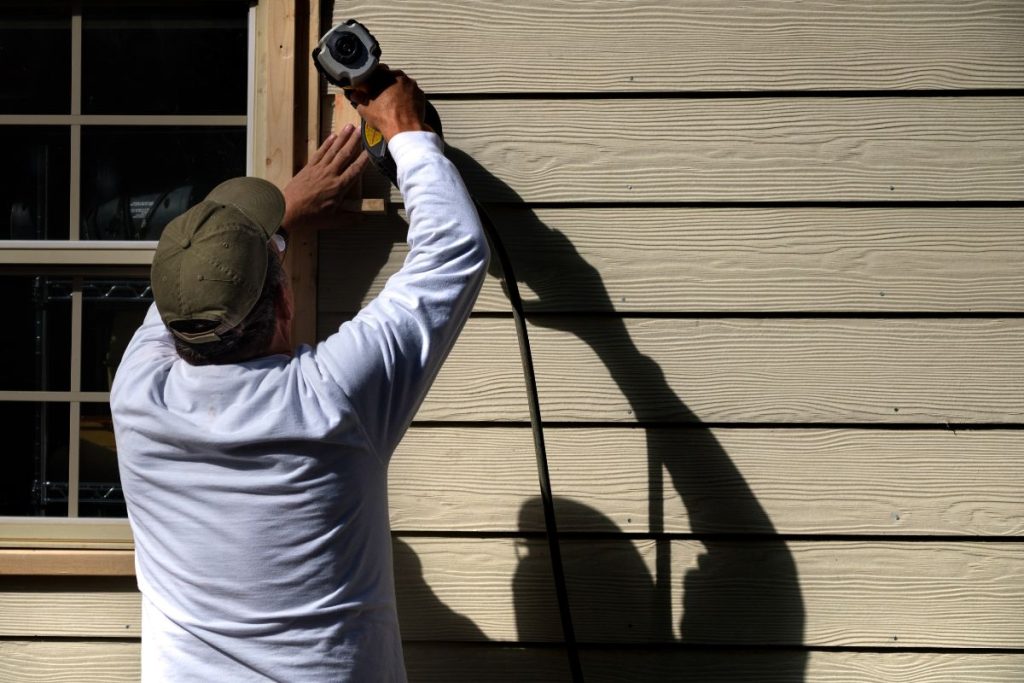Stucco siding is like that timeless piece in your wardrobe – it never really goes out of style. You’ve seen it on everything from sleek desert homes to old-school Spanish villas, and it still holds its own today.
So what’s the big deal? Stucco is a mix of cement, sand, lime, and water that hardens into a clean, textured finish. Translation: it looks sharp, lasts for decades, and doesn’t demand endless upkeep.
If you’re weighing siding options, this one’s worth a serious look. It’s affordable, durable, and flexible enough to match modern or classic vibes. Think of it as a cheat code for boosting curb appeal without draining your wallet.
How durable is stucco siding compared to other options?
Stucco siding can last 50–80 years with proper care, making it one of the longest-lasting exterior finishes available.
Key Takeaway
- Stucco siding = cement, sand, lime, and water mix with a textured finish.
- Lasts 50–80 years with proper care.
- Affordable, durable, and fire/pest/weather resistant.
- Works best in dry, warm climates.
- Needs pro installation and regular crack repairs.
History and Origins
Stucco isn’t some new Pinterest trend. It’s been around since ancient times, with roots in Greek and Roman architecture. Builders loved it because it mixed lime, sand, and water into a tough, weather-resistant coat.
Fast forward a few centuries, and Spanish settlers brought it to the Americas, where it became a go-to for hot, dry climates. Today, it’s evolved with modern materials but still carries that old-world charm that keeps homes looking stylish and solid.

Types of Stucco Siding
Traditional Stucco: This is the OG version. Made from cement, lime, sand, and water, it’s applied in layers right onto your walls. It’s tough, long-lasting, and brings that timeless, earthy vibe.
Synthetic Stucco (EIFS): Think of this as stucco’s modern cousin. It uses foam board insulation with a thin acrylic finish on top. The big flex here? Better energy efficiency and fewer cracks if done right.
One-Coat Stucco: The fast-track option. Instead of three coats, this uses a cement mix reinforced with fiberglass in just one shot. It saves time without totally sacrificing durability. Perfect if you want that stucco look without the long wait.
How Stucco Siding Is Installed
Stucco siding isn’t something you just slap on a wall. First, a waterproof barrier and metal lath get secured to the exterior, creating the base layer that holds everything together.
Next comes the scratch coat, a rough layer of cement that gives the finish something to grip. After that, a brown coat smooths things out and sets the stage.
Finally, the colour coat is applied, giving you that polished look and lasting protection. It’s a layered process, and while it looks simple, getting it right takes pro-level skill. Done well, your stucco siding turns into a durable flex that can outlast most trendy finishes.
Pros of Stucco Siding
Stucco siding is like the low-maintenance friend who always shows up looking sharp. It doesn’t demand constant upkeep, so you can skip the endless weekend projects. A quick wash here and there, and it stays fresh.
It’s also a tank when it comes to durability. Stucco holds up against fire, pests, and crazy weather, making it a smart play if you want siding that won’t flinch under pressure.
Style-wise, stucco is versatile. You can go smooth and modern or textured with character. The colour is baked in, so fading and peeling aren’t daily worries. If you want siding that blends strength, style, and simplicity, stucco’s got your back.
Cons of Stucco Siding
Stucco isn’t all sunshine and smooth finishes. It’s tough, but not invincible. Cracks can creep in over time, especially if the foundation shifts or the install wasn’t done right.
Moisture’s another headache. If water sneaks behind the stucco, it can trap damage inside your walls. That means costly repairs if you don’t catch it early.
It’s also not the cheapest option upfront. Between skilled labour and prep work, you’ll pay more than for vinyl or aluminium. But if you love the look, think of it as a long-term investment that just needs a little extra TLC.
Maintenance and Care Tips
Regular Cleaning: Stucco looks fresh with a simple wash. Use a garden hose and soft brush to clear off dirt before it builds up. Skip the pressure washer, it’s too harsh.
Fix Cracks Early: Hairline cracks? Don’t ignore them. Seal them up fast to block water from creeping in and causing bigger issues.
Watch for Stains: Dark spots usually mean moisture. Spot them early and call in a pro before mould or rot tags along.
Annual Check: Walk around your place once a year. Quick scan, quick fixes, and your stucco stays looking sharp.
Cost of Stucco Siding
Stucco siding sits in the middle of the price spectrum. It’s not bargain-bin cheap, but it won’t drain your savings either.
The total cost usually depends on factors like house size, prep work, and the finish style you choose. Smooth textures, colours, and detailing can nudge the price higher.
Think of it as a long-term play. You’re paying a bit more upfront, but you get durability and curb appeal that stick around for decades.
How Long Does Stucco Siding Last?
Stucco isn’t some quick fling, it’s a long-term relationship. Done right, it can last 50 to 80 years, which is wild compared to other siding options.
The trick is giving it a little love now and then. Patch small cracks early, keep moisture away, and you’ll have a solid, stylish exterior that sticks around for decades without drama.
Is Stucco Siding Right for Your Home?
Stucco siding flexes best in dry, warm climates. If you’re in the desert or somewhere with mild seasons, it’s a win. It brings a sleek, timeless look and keeps maintenance low.
But if your place gets constant rain or freeze-thaw cycles, stucco might crack under pressure. Bottom line? It’s perfect if you want a stylish, durable shell and your weather plays nice.
FAQs: Stucco Siding
1. How long does stucco siding last?
With proper care, stucco can hold strong for 50+ years. The key is sealing cracks early and keeping moisture out.
2. Is stucco siding good for all climates?
It thrives in dry, warm areas. In super wet or freeze-thaw regions, you’ll need extra maintenance to avoid cracks.
3. Can stucco siding be painted?
Yes, you can paint it. Just use breathable exterior paint so moisture doesn’t get trapped inside.
4. Is stucco siding expensive?
It usually costs more upfront than vinyl, but it pays off in durability and insulation. Think long-term savings.
5. How do I maintain stucco siding?
A quick wash once a year, sealing small cracks, and checking for moisture spots keeps it looking sharp.
Conclusion
Stucco siding is that rare mix of style and staying power. It gives your place texture, protects against the elements, and if you keep it maintained, it’ll hold up for decades.
If you’re weighing options, think about your climate, budget, and how much upkeep you’re cool with. Play it smart, and stucco can be both your home’s armour and its flex.








